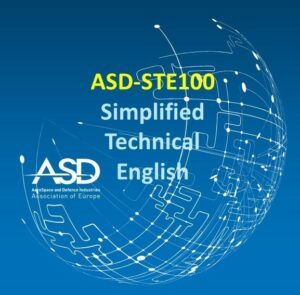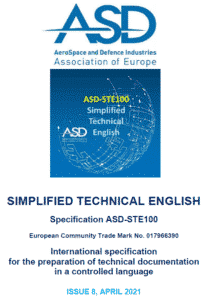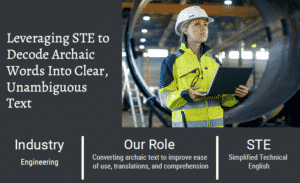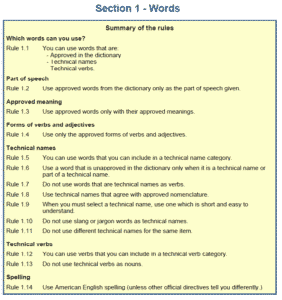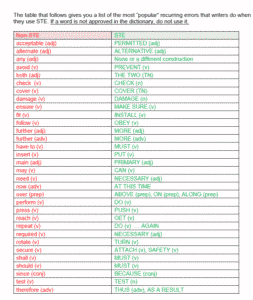Simplified Technical English
STE Writing Rules
English Simplified

“Simplified Technical English, STE, was developed to help the readers of English-language documentation understand what they read, particularly when these readers are non-native English speakers.” – ASD-STE100
Why Use STE Writing Rules?
Simplified Technical English is worth it for one very important reason: Your audience will love it (and you)!
▪ Compliance with ASD-STE100
▪ Quality assurance and improvement
▪ Standardized way of writing
▪ Reduced word count
▪ Improved safety
▪ Efficient authoring
▪ Quality improvement in writing and translations
▪ Improved customer experience
▪ Facilitates content management, XML
▪ Reduction in overall documentation cost
▪ Cheaper, faster and better translations
Let Us Tell You How We Can Improve Your Documentation With STE
Check out our new downloads section.
Simplified Technical English (STE) Services
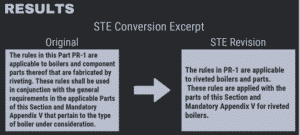
Leveraging STE
Professional Simplified Technical English (STE) Services
Becoming compliant with Simplified Technical English (STE) standards can create clear, unambiguous text that defies misinterpretation, promotes safety and reduces costs (especially translation). Becoming compliant can also be difficult and time-consuming because of the STE structure. Online STE checkers can provide direction but the simple fact is that they cannot do the actual conversion work: No STE checker exists that will automatically convert regular text into STE-compliant text. That is why we offer professional STE consulting, conversion and translation services that transform your text into simplified technical English.
Quick Links
Services
This is a noninclusive list of our Simplified Technical English services. Contact us if you need an STE service that is not listed here.
- Conversion of highly-technical standard text into STE-compliant text
- Conversion of standard text into STE-compliant text–e.g., manuals, employee handbooks, abstracts, online content, etc.
- Evaluation of standard text to identify changes that might make the text STE-compliant (contact us for sample)
- E-Learning Material conversion.
Simplified Technical English
Creating an STE-compliant document is easy: Follow the STE writing rules. This sounds simple but it is harder than it looks. If it were not, there would be many more documents written in this style The Simplified Technical English Bible is the ASD-STE100, Issue 8, STE Writing Rules.
Using technical jargon is not the issue. The goal is to write clear, unambiguous text that contains the technical jargon.
“Complex technical instructions can be misunderstood and misunderstandings can lead to accidents. STE makes technical texts easy to understand by all readers“
Simplified Technical English may be what you need if your document has a wide, diverse audience.
Downloads
ASD-STE100, Issue 8
This free download is the full text of the ASD-STE100, Issue 8, International Specification for the Preparation of Technical Documentation in a Controlled Language
Leveraging STE
Case study of a Simplified Technical English (STE) conversion in the Engineering sector. The conversion was intended to remove the archaic wording and make the text easier to translate and understand. The transformation resulted in reduced cost and better translations.
What Are the Simplified Technical English Rules?
STE addresses difficulties in English comprehension related to complex sentence structures, confusing word forms, and ambiguous vocabulary. STE has two parts: a set of writing rules (part 1) and a controlled dictionary (part 2). The writing rules cover aspects of grammar and style. The dictionary gives the general words that a writer can use.
STE Writing Rules
STE WRITING RULES
- Restrict the length of noun clusters to no more than three words
- Restrict sentence length to no more than 20 words (procedural sentences) or 25 words (descriptive sentences)
- Restrict paragraphs to no more than 6 sentences (in descriptive text)
- Avoid slang and jargon while allowing for specific terminology
- Make instructions as specific as possible
- Use articles such as “a/an” and “the” wherever possible
- Use simple verb tenses (past, present, and future)
- Use active voice
- Do not use present participles or gerunds (unless part of a Technical Name)
- Write sequential steps as separate sentences
- Start a safety instruction (a warning or a caution) with a clear and simple command or condition.
The Writing Rules differentiate between two types of topics: procedure and description. The Writing Rules also specify restrictions on grammar and style usage.
Controlled Dictionary
STE has a controlled general dictionary that gives the words that are most frequently used in technical writing.
The approved words were selected because they were simple and easy to recognize. In general, each word has only one meaning and functions as only one part of speech. For example, “to fall” has the approved meaning of “to move down by the force of gravity,” and not “to decrease”.
When there are several words in English for the same thing (synonyms), STE permits one of these synonyms to the exclusion of the others. For example, STE uses “start” instead of “begin”, “commence”, “initiate”, or “originate”. STE approved meanings and spelling are based on American English (Merriam-Webster’s dictionary).
In addition to its general dictionary, STE permits the use of company-specific or project-oriented technical words (referred to in STE as technical names and technical verbs). These words are related to the categories listed in the respective rules.
Basically, writers can use the approved words in the dictionary as a core vocabulary. But they can also use terms that are usual in their companies or industries and applicable to their projects and products.
What is ASD-STE100?
ASD-STE100
ASD SIMPLIFIED TECHNICAL ENGLISH
SPECIFICATION ASD-STE100
EUROPEAN UNION TRADE MARK NO. 017966390
INTERNATIONAL SPECIFICATION FOR THE PREPARATION OF TECHNICAL DOCUMENTATION IN A CONTROLLED LANGUAGE
According to the ASD-STE100 website, English is the international language of science, technology and human relations. It is also the language of the aerospace and defense industry. However, it is not often the native language of the readers of technical documentation. Many readers have a limited knowledge of English. Complex sentence structure and the large number of meanings and synonyms that many English words have can cause confusion.
On June 30, 1983, in Amsterdam, the AECMA Simplified English Working Group was founded and the AECMA Simplified English project started.
The product of this effort was the AECMA Simplified English Guide (first release in 1986) which, in 2005, became the ASD Simplified Technical English Specification, ASD-STE100.
The success of STE is such that other industries use it beyond its original intended purpose of aerospace maintenance documentation. Interest in STE has also increased dramatically in the areas of language services, professional translation and interpreting, as well as in the academic world.
Use This, Not That: STE Writing Rule 1.1
Simplified Technical English Begins With STE Writing Rule 1.1
Simplified Technical English (STE) has a controlled general dictionary (part 2) that gives you the words most frequently used in technical writing.
You can also use words that are not in the dictionary if you can include them in the specified categories of technical names and technical verbs.
The dictionary also gives a selection of unapproved words, with examples that show how to use alternative words.
Which Words Can You Use?
You can use words that are:
- Approved in the dictionary
- Technical names
- Technical verbs.
Examples:
The word “use” is an approved word in the dictionary.
The word “engine” is a technical name.
The word “ream” is a technical verb.
Let Us Tell You How We Can Improve Your Documentation With STE
WE WILL BE WORKING OVER THE HOLIDAYS
A key goal in translation is interpreting the author’s intention. Translating a text to or from STE is made easier by reducing sentences to their core intended meaning. This allows STE to be used in the translation of documents into multiple languages at one time, giving a framework of sentence structure that can be more easily altered than standard English to suit the sentence syntax and structure in other languages.
